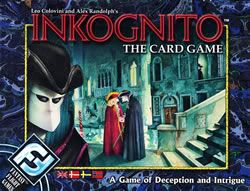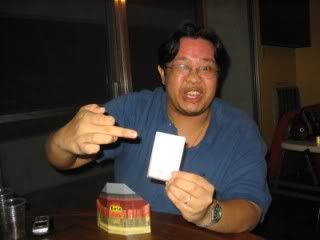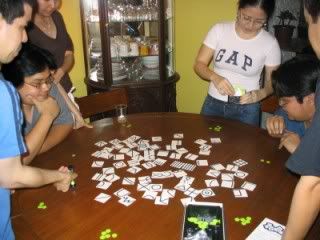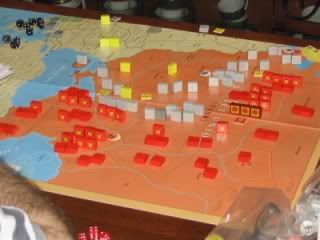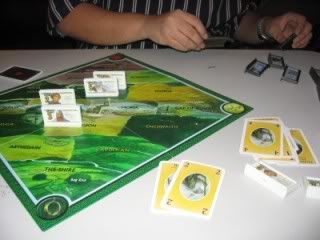"That is not dead which can eternal lie,
And with strange æons, even death may die"
Welcome my child. You seek the secrets of the Great Old Ones?
You play with fire.
But, ‘tis not my place to judge your desires, but simply to enable them. Your journey will take you into the dark depths of the shadows, where Things That Should Not Be lurk, and your very perception of reality will be challenged. Some already know of the Dwellers on the Dark, and are striving to uncover the secrets as we speak. Other have already stared at the maw of horror. There are those that have gone mad. There are those that have taken a shotgun and emptied it into that which they do not understand, with varying results.
Of course, there are those who choose to worship the Things That Should Not Be. They will oppose you at every turn, with the power granted to them by the Great Old Ones.
Should you still wish to learn of matter that will eventually drive you to the brink of insanity, follow me.
Ph'nglui mglw'nafh Cthulhu R'lyeh wgah'nagl fhtagn!
There are normally two ways into the works of Howard Phillips Lovecraft. The first and most common way is through his stories, which have been published in many compendiums. The stories have also served as influences for many latter day horror fiction authors. The most famous of these works are “The Dunwich Horror,” “The Shadow over Innsmouth,” “At the Mountains of Madness,” and of course “The Call of Cthulhu.” The other entry point to Lovecraftian horror is the classic roleplaying game The Call of Cthulhu, published by Chaosium (a variation on the game was published later by Wizards of the Coast).
Since this isn’t a literary or RPG review, I’ll just try to impart the flavor of Lovecraftian horror, so that the game makes more sense a bit later on. To readers who have stronger grounding in the source material, my apologies if I gloss over facts and generalize a bit too much. There’s so much to the Cthulhu Mythos that it’s not possible to do it justice in a game review.
Earth, in the Lovecraftian universe, is not alone. Great star-spanning races exist, both far in Earth’s past and far into Earth’s future. We Earthlings are largely unaware of these beings. At some point in the past, several of these beings decided to come to Earth. They stayed a while, ruled over the planet, and eventually lost their ability to traverse space and time. Wars were waged between these beings for supremacy, until they did each other in. They weren’t all destroyed though, just put out of commission for a while.
The time is the 1920s. Strange things are happening in the fringes, the kind of things you read about in tabloids and whisper about when discussing conspiracy theories. Some people actually have to deal with these things in the course of their work. You know the types – cops and feds with weird cases on their hands, journalists chasing down a story that just feels wrong, criminals looking for an edge, scholars draws by knowledge of the strange and otherworldly and regular people who are just too nosy for their own good. These people ask too many questions which lead to answers which usually only raise more questions. Sometimes, they find an answer.
The answers can be as simple as strange cults with strange practices doing strange things. They can be musty old tomes written in spidery languages which seem to mean absolutely nothing. Or, the answers can say that there are godlike beings on earth, sleeping, and their servants are trying to wake them up so that they can take over the world.
The theme of The Call of Cthulhu is that of a shattered reality. When Occam’s Razor says that the answer is something that doesn’t mesh with what we accept to be reality, people go insane. Horror isn’t the dead rising to eat your brains, or ghosts haunting a mansion, or inhuman monsters terrorizing a town (though those can certainly be part of the big picture). Horror is realizing that what you knew to be isn’t.

The Call of Cthulhu CCG (CoCCCG) is published by Fantasy Flight Games. As of this writing, it has a base set, called the Arkham Edition, composed of 290 cards. It also has two expansions out – Unspeakable Tales, and the new Forbidden Relics. A second edition, called the Eldritch Edition, has been announced.
The game, like most CCGs comes in starters and boosters. There are two flavors of starters, the Mythos Deck and the Investigators Deck. Each starter consists of a set of fixed cards, some of which are required to play the game, and a set of random cards. The Mythos Deck is essentially a “bad guys” deck, composed of cards loyal to two of the Lovecraftian gods, Hastur and Cthulhu himself (itself?). The Investigators Deck has cards representing the “good guys,” the scholars and mystics of the Miskatonic University, and the gun-toting members and allies of the Blackwood Detective Agency. (This being Lovecraft, “bad” and “good” is relative.) The boosters contain 11 random cards.
The art is, well, remarkable, and is what led me to investigate this game. I’ve seen a LOT of CCGs over the years, with all sorts of themes. I haven’t seen anything better than the art of CoCCCG. It’s times like this when I wish that cards had more space for art, because some of the pieces are, well, insanely fantastic. Many are Lovecraftian pieces, of course, so by and large they’re equal parts creepy, spooky, dark and gloomy. Predictably, the Mythos cards have the more memorable art. The rest of the graphic design on the cards is very good, if slightly busy. The text is readable, and some cards have quotes from HPL’s works. The cards themselves are of good quality. They’re reasonably thick, smooth and shuffle well. Still, an investment in a good set of card sleeves is a good idea if you plan to play with them. Or you can just stick them in a binder and admire the art.
The rules that come with the Starters are functional, but I’d recommend getting the latest update from the FFG website. There are some clarifications and restatements that will help you follow the game flow.
Overall, the looks of CoCCCG represent a top-notch job from the folks at Fantasy Flight.
The Game
In CoCCCG, a player represents one or more factions that are vying for control over certain stories. The first player to take control of three stories wins the game.

There are seven “factions” in CoCCCG. Four of them are Mythos factions, representing four of the Great Old Ones – Hastur the Unspeakable, Yog-Sothoth the Keeper of the Gates, Shub-Niggurath the All-Mother, and of course Great Cthulhu. The other three factions are the humans – Miskatonic University (scholars and mystics, including some well-known Lovecraft characters), the Blackwood Detective Agency (mostly lawmen, investigators and journalists), and The Syndicate (criminals). The catch is that none of these factions need be allied one way or another. Thematically, it works. You can make a “corrupted cops” combo using Blackwood and Cthulhu, or “scholars who sold their sanity for knowledge” by putting Miskatonic into a deck with Hastur, and so on. The Mythos Deck out of the box is rather strange, since Cthulhu and Hastur aren’t the best of buddies, but I guess it’s possible for their minions to work in the same direction without actually being friendly.
The Story Cards are the object of the game. The players are trying to take control of these cards by sending their minions to “work” on the story. Stories are drawn from a shared deck of ten, and there are three in play at any time. Once a player wins a story, it is replaced by a new one. Each Story also has a game effect once claimed by a player; the player who claims it decides if the effect goes off or not. Once a player claims his third story, he wins the game. Stories have really nice art, and some of them take the titles of Lovecraft stories or settings, like The Innsmouth Threat and The Terror out of Dunwich.
CoCCCG’s resource system is interesting. A Starter comes with three Domain Cards, which each depict a third of one of the pieces of art on the Story Cards. Players take cards from their hand, flip them upside-down and stick them under the Domain Cards. For each card under a Domain, it provides one resource point. You “exhaust” the Domain, generating an amount of resources equal to the cards underneath that domain, and you can use those resources to play ONE card with a cost equal to or less than the generated resources. So, theoretically, unless you somehow create more Domains, you can only play three cards per turn. (Yes, there are ways to get more Domains.)
So, since your cards in hand are both your source of resources, and they’re the things that you play, there’s always the tough decision of putting down more resources for speed, or holding back for more options. A player only draws two cards a turn under normal circumstances, so there’s a card crunch all the time. It’s both a deck construction and a game play dilemma that players have to resolve.
There are three kinds of cards to play. Characters are the most important ones, and can be anything from a lowly filing clerk and a street thug, to the renowned Professor Armitage and Great Cthulhu. Support cards are the catch-all for things that stay on the board, and can be things that characters use (guns), places, arcane spells, curses and anything in between. Finally, Events are usually one-shot deals with all kinds of effects.
The Story Phase is where the action is. Players assign characters to engage stories. Their opponents also assign characters to oppose the active player’s minions within the story. Once the characters have been placed in the story, a set of four “struggles” is triggered. Struggles are resolved with icons; each character might have one or more of them, and support and event cards can also grant them or take them away. It’s pretty simple – the side with more of a type of icon wins that struggle. Ties indicate no winner.
I’ll go over them because I think they’re fun. The Terror Struggle is when characters meet things that challenge their sanity. The side that loses has one character go insane. Then there’s the Martial Struggle, where the sides duke it out with guns, claws and tentacles. One character on the losing side takes a wound. Most characters can only take one wound before expiring. Then, it’s on to the Arcane Struggle. The winner of the Arcane Struggle gets to untap one of his characters (characters tap when they engage a story). Finally, the Investigative Struggle occurs. The winner gets a story point. When that’s all over, the two sides add the total Skill (each character has a Skill rating) of their characters that are still active at the Story. If the active player’s Skill is equal to or higher than the defender, he gets a Story Point. If the defender has no characters left defending at this point, an additional Story Point is awarded. Five Story Points means that the story is won by that player.

Play then passes to the other player, who untaps everything on his side, gets a character back from the loony bin if he had any insane characters, and takes his turn.
Since this is a CCG, expect that gameplay can be modified by all sorts of cards.
Strategy
I won’t go into this too much since I’ve only played with a limited number of the 600+ cardset currently on the market. However, it’s clear that each faction has its strengths, and pairing different factions together creates different dynamics. The out of the box Investigator combo of Miskatonic and Blackwood produces a fast deck of lowish-skill characters with good martial skills and good investigative skills. Their out-of-the-box opponents serving Hastur and Cthulhu are heavy on the scary (terror icons out the wazoo), decent on the martial but not so hot on much else. They’re also slower, but they have some scary heavy hitting Mythos creatures that the humans will have trouble dealing with.
The basic CoCCCG game is a creature battle, with the humans trying to solve stories quickly before the ugly critters appear. Once they do appear, the humans have to be sneaky and get around the scaries without going nuts. Hopefully, they’ll have gained one or two stories by then, with enough of a lead on the balance they need that a couple of snipes and stealthy plays will get them the last story points to win.
The Mythos side has to hold out long enough by interposing cannon fodder into the way of the humans until able to summon the creepy-crawlies. Once older Deep Ones, Byakhees and Shoggoths start showing up at stories to drive the humans batty, it’s only a matter of time until the Mythos wins on sheer terror.
Again, since this is a CCG, there will be all sorts of combos and deck strategies available if you’re the kind of person that’s able and willing to spend on a CCG for power or completeness. As more expansions appear, more strategies will become available.
Reviewer’s Tilt
I guess the best compliment you can give a CCG is to spend money on it. CoCCCG is the first CCG I’ve spent significant cash on since Magic: the Gathering and I’d say that that’s a pretty good compliment.
CoCCCG is not a simple game, a fast game or an elegant game. It’s got a lot of moving parts, a lot of icons, and a lot of text effects even in its simplest out-of-the-box configuration. It feels clunky when you play it. Strangely, the clunkiness feels right for a Lovecraftian game, sort of like how the Chaosium Call of Cthulhu RPG feels. Neither game is the pinnacle of engineering as far as their genre goes, but they fit their niche just right.
I would consider CoCCCG as innovative, and most importantly, flavorful. The battle over stories is a great thematic element. The individual struggles are also a great thematic element. I enjoy the order in which they occur. After all, you have to maintain your sanity in order to shoot straight, you have to survive the combat before you can cast a spell, and you only get time to breathe and investigate after everything else.

Like many CCGs early in their card universe development, I’d expect that some balance issues would occur. CoCCCG has some of the benefit from following its older sibling, the A Game of Thrones CCG, and applying lessons learned (such as the huge “costless Events” problem). However I don’t think you’ll encounter these problems at a “casual player” investment level. You don’t even have to go by conventional deckbuilding wisdom. I’ve been enjoying playing my clunky “crazy dirty cops” deck featuring Hastur, Blackwood and the Syndicate. It’s slow, it doesn’t win a lot, but driving opposing characters nuts then blowing them away with firepower supported by dirty money is loads of fun.
If you’re a Lovecraft fan, you’ve got to at least check this game out, if only for the artwork on the cards. You can’t go wrong by getting just the two Starters; they’re playable out of the box. If you like good CCGs, then this is also a good one to look at if only for its thematic gameplay. Finally, yes, this is a collectible card game. If you dislike the concept in principle, then this isn't for you. If all you want is a fun Cthulhu Mythos game with great flavor, beautiful art and interesting gameplay, you might want to consider a couple of CoCCCG Starters.


